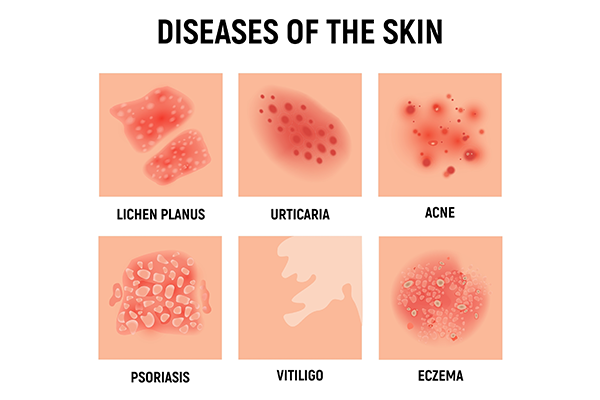
Your skin is your body's largest organ, and any visible irritation, such as red rashes, can be a sign of underlying imbalances or reactions. From mild itchiness to painful swelling, skin rashes are one of the most common complaints in dermatology. In this guide, we’ll explore the various types of red rashes, their warning signs, potential causes, and suitable treatments.
If you're looking for professional dermatology care, Manipal Hospital Kharadi offers tailored skin treatment solutions using advanced techniques and compassionate care.
Synopsis
What Are Skin Rashes?
A skin rash describes any noticeable change in the skin’s colour, feel, or overall appearance. Red patches are the most frequently reported kind, often accompanied by itching, stinging, or tenderness. These may affect a small patch or cover a larger area of the body.
Some rashes are temporary and caused by harmless irritants, while others may be a sign of more serious medical conditions and require prompt attention.
Different Types of Skin Rashes
Knowing the type of rash you're dealing with helps ensure timely and appropriate care. Here are the most common forms that people experience:
1. Contact Dermatitis
-
Trigger: Skin reacting to direct contact with an irritant or allergen such as soaps, plants, or jewellery.
-
What it looks like: Inflamed, red, and sometimes blistered skin at the point of contact.
-
How to manage it: Identify and avoid the trigger; use emollients and steroid creams as prescribed.
2. Eczema (Atopic Dermatitis)
-
Trigger: Often genetic, worsened by environmental or immune system factors.
-
What it looks like: Dry, flaky, and itchy skin that may crack or ooze.
-
How to manage it: Frequent moisturising, mild topical steroids, and oral antihistamines during flare-ups.
3. Psoriasis
-
Trigger: A chronic autoimmune condition causing accelerated skin cell production.
-
What it looks like: Thick, silvery scales or red patches, typically on elbows, knees, and scalp.
-
How to manage it: Treatment may involve creams, UV light therapy, or immune-modulating drugs.
4. Heat Rash (Prickly Heat)
-
Trigger: Excessive sweating leads to blocked sweat glands.
-
What it looks like: Tiny red bumps or clear blisters, usually found in body folds.
-
How to manage it: Stay cool, wear loose cotton clothing, and maintain skin hygiene.
5. Hives (Urticaria)
-
Trigger: Allergic response to food, medicines, insect bites, or stress.
-
What it looks like: Raised, itchy welts that appear suddenly and may change shape or location.
-
How to manage it: Oral antihistamines and avoiding identified allergens.
6. Fungal Skin Infections
-
Trigger: Growth of fungi in warm, damp environments—often affecting feet, groin, or underarms.
-
What it looks like: Ring-shaped, itchy rashes with red outer edges.
-
How to manage it: Antifungal lotions, powders, and keeping the area dry and clean.
At Manipal Hospital Kharadi, specialists thoroughly assess each case to ensure the most effective approach to treatment and recovery.

Recognising Skin Rash Symptom
Skin rashes may differ in appearance and severity. Key signs to look out for include:
-
Reddish patches or general inflammation
-
Persistent itching or discomfort
-
Flaky, dry, or peeling skin
-
Blisters, bumps, or pus-filled spots
-
Warmth, pain, or tenderness in the area
-
Fever or chills, in case of infection
-
Swelling, especially if accompanied by oozing
If your skin changes are unusual, worsening, or not responding to home care, it’s best to seek guidance from a medical professional.
What Causes Red Rashes on Skin?
Red rashes can develop due to several underlying reasons. Identifying the specific cause helps in choosing the right course of treatment. Some common contributors include:
-
Allergic reactions: Dust, pet dander, certain foods, latex, or medications
-
Irritants: Harsh detergents, fragrances, or fabrics
-
Climate factors: Heat, humidity, or excess sweating
-
Infections: Viral (e.g., chickenpox), fungal (e.g., ringworm), or bacterial (e.g., impetigo)
-
Immune conditions: Like lupus, eczema, or psoriasis
-
Medications: Antibiotics, aspirin, or anti-seizure drugs
-
Insect bites: Often lead to local swelling, redness, and itching
Dermatologists at Manipal Hospital Kharadi conduct patch tests, blood work, or skin scrapings to determine the root cause before recommending treatment.
How Are Skin Rashes Treated?
Managing skin rashes effectively depends on the diagnosis, intensity, and underlying cause. A combination of approaches may be used:
Topical Options
-
Anti-inflammatory creams to reduce redness and swelling
-
Antifungal or antibacterial ointments for infections
-
Calming moisturisers to support the skin barrier
Oral Medicines
-
Antihistamines to ease allergic itching
-
Antibiotics in cases of bacterial infection
-
Immunosuppressive medications for chronic inflammatory rashes
Lifestyle & Home Remedies
-
Identify and avoid known triggers
-
Stick to gentle, unscented skincare products
-
Keep the skin clean, cool, and moisturised
-
Choose breathable fabrics like cotton
Advanced Dermatology Treatments
-
Light therapy for autoimmune-related rashes
-
Biologic injections for severe cases of psoriasis
-
Laser treatments for persistent vascular or pigmented rashes
The dermatology department at Manipal Hospital Kharadi ensures that every patient receives a tailored treatment plan based on their skin type, medical history, and symptoms.
When Should You Consult a Skin Specialist?
Though many rashes are harmless, some require professional attention. Make sure to consult a top dermatologist if:
-
The rash spreads rapidly or becomes painful
-
You develop a high temperature or feel generally unwell
-
Blisters, pus, or open wounds appear
-
There is no improvement with over-the-counter care
-
Sensitive areas like the eyes or genitals are affected
-
You have a weakened immune system or chronic illness
Ignoring warning signs may lead to scarring or complications—don’t delay care.
Why Choose Manipal Hospital Kharadi?
For those seeking expert dermatological evaluation, Manipal Hospital Kharadi provides:
-
A skilled team of skin care specialists
-
State-of-the-art technology for accurate diagnosis
-
Personalised treatment strategies for all skin concerns
-
A focus on long-term skin health and patient awareness
-
Care tailored for both adults and children
Conclusion
Red rashes on the skin should never be ignored. Whether they arise due to an allergy, infection, heat, or immune-related condition, early detection and proper treatment are essential. By recognising symptoms and understanding the types of rashes, you can act quickly to manage the issue.
For expert care and peace of mind, visit Manipal Hospital Kharadi, where your skin health is in capable hands.
FAQ's
Allergies, infections, heat, or irritants often cause red rashes on skin. Visit Manipal Hospital Kharadi for an accurate diagnosis.
Common skin rash types include eczema, psoriasis, contact dermatitis, and fungal infections. Manipal Hospital Kharadi offers expert evaluation.
Skin rash symptoms include redness, itching, swelling, and blistering. If persistent, consult Manipal Hospital Kharadi’s dermatology specialists.
Skin rash treatment includes creams, antihistamines, or advanced therapies depending on the cause. Manipal Hospital Kharadi provides tailored care.
If red rashes on skin worsen or spread, see a dermatologist at Manipal Hospital Kharadi promptly.





















 6 Min Read
6 Min Read
















